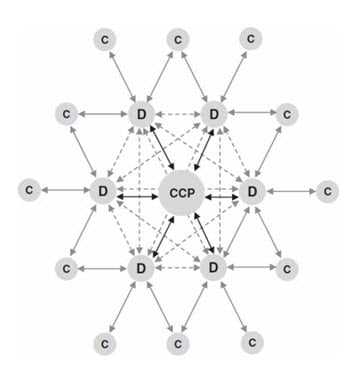Learning objectives: Compare margin requirements in centrally cleared and bilateral markets, and explain how margin can mitigate risk. Compare and contrast bilateral markets to the use of novation and netting. Assess the impact of central clearing on the broader financial markets.
Questions:
604.1. A central counterparty (CCP) is evaluating a new derivative instrument as a possible candidate for trading on its central clearing platform. The following four features are associated with the candidate derivative instrument. Which of the following is MOST LIKELY to render the instrument incompatible with central clearing?
a. The candidate derivative instrument requires heterogeneous (ie, non-standard) legal terms such that each contract is unique
b. The candidate derivative instrument is simple (ie, not complex) however valuation models are quite sensitive to input assumptions
c. Several of the counterparties, who are interested to trade the candidate derivative instrument, are not currently members of the CCP
d. The candidate derivative instrument has an historical price volatility that is significantly above average, although volume has been deep
604.2. Below is Gregory's illustration of a centrally clearing market [Gregory Figure 3.6] (Source: John Gregory, Central Counterparties: Mandatory Clearing and Bilateral Margin Requirements for OTC Derivatives (New York: John Wiley & Sons, 2014))

About this market, each of the following is true EXCEPT which is false:
a. The dotted lines represent non-cleared bilateral trades between members ("D" for dealers)
b. Non-clearing member (aka, "C" for clients) will contribute to the CCP default fund but will not be required to post margin
c. Non-clearing members (aka, "C" for clients) are likely to have relationships with more than one clearing member ("D" for dealers)
d. Non-clearing members (aka, "C" for clients) can clear through a member ("D" for dealer) vis a principal-to-principal or agency method
604.3. Each of the following arguments about the future of central counterparties (CCPs) is true, according to Gregory, except which is FALSE?
a. CCP disadvantages include vulnerability to moral hazard and adverse selection, and the possibility of pro-cyclical effects
b. It seems likely that there will be a relatively large number of CCPs due to bifurcation on two levels: regional and product
c. CCPs are unlikely to fail, due to margins, but if a CCP fails, a redeeming quality is that its bailout should be relatively simple
d. accordance with a sort of "conservation of risk" principal, CCP will not so much reduce counterparty risk as transform it into different forms
Answers here:
Questions:
604.1. A central counterparty (CCP) is evaluating a new derivative instrument as a possible candidate for trading on its central clearing platform. The following four features are associated with the candidate derivative instrument. Which of the following is MOST LIKELY to render the instrument incompatible with central clearing?
a. The candidate derivative instrument requires heterogeneous (ie, non-standard) legal terms such that each contract is unique
b. The candidate derivative instrument is simple (ie, not complex) however valuation models are quite sensitive to input assumptions
c. Several of the counterparties, who are interested to trade the candidate derivative instrument, are not currently members of the CCP
d. The candidate derivative instrument has an historical price volatility that is significantly above average, although volume has been deep
604.2. Below is Gregory's illustration of a centrally clearing market [Gregory Figure 3.6] (Source: John Gregory, Central Counterparties: Mandatory Clearing and Bilateral Margin Requirements for OTC Derivatives (New York: John Wiley & Sons, 2014))

About this market, each of the following is true EXCEPT which is false:
a. The dotted lines represent non-cleared bilateral trades between members ("D" for dealers)
b. Non-clearing member (aka, "C" for clients) will contribute to the CCP default fund but will not be required to post margin
c. Non-clearing members (aka, "C" for clients) are likely to have relationships with more than one clearing member ("D" for dealers)
d. Non-clearing members (aka, "C" for clients) can clear through a member ("D" for dealer) vis a principal-to-principal or agency method
604.3. Each of the following arguments about the future of central counterparties (CCPs) is true, according to Gregory, except which is FALSE?
a. CCP disadvantages include vulnerability to moral hazard and adverse selection, and the possibility of pro-cyclical effects
b. It seems likely that there will be a relatively large number of CCPs due to bifurcation on two levels: regional and product
c. CCPs are unlikely to fail, due to margins, but if a CCP fails, a redeeming quality is that its bailout should be relatively simple
d. accordance with a sort of "conservation of risk" principal, CCP will not so much reduce counterparty risk as transform it into different forms
Answers here:
Last edited:
